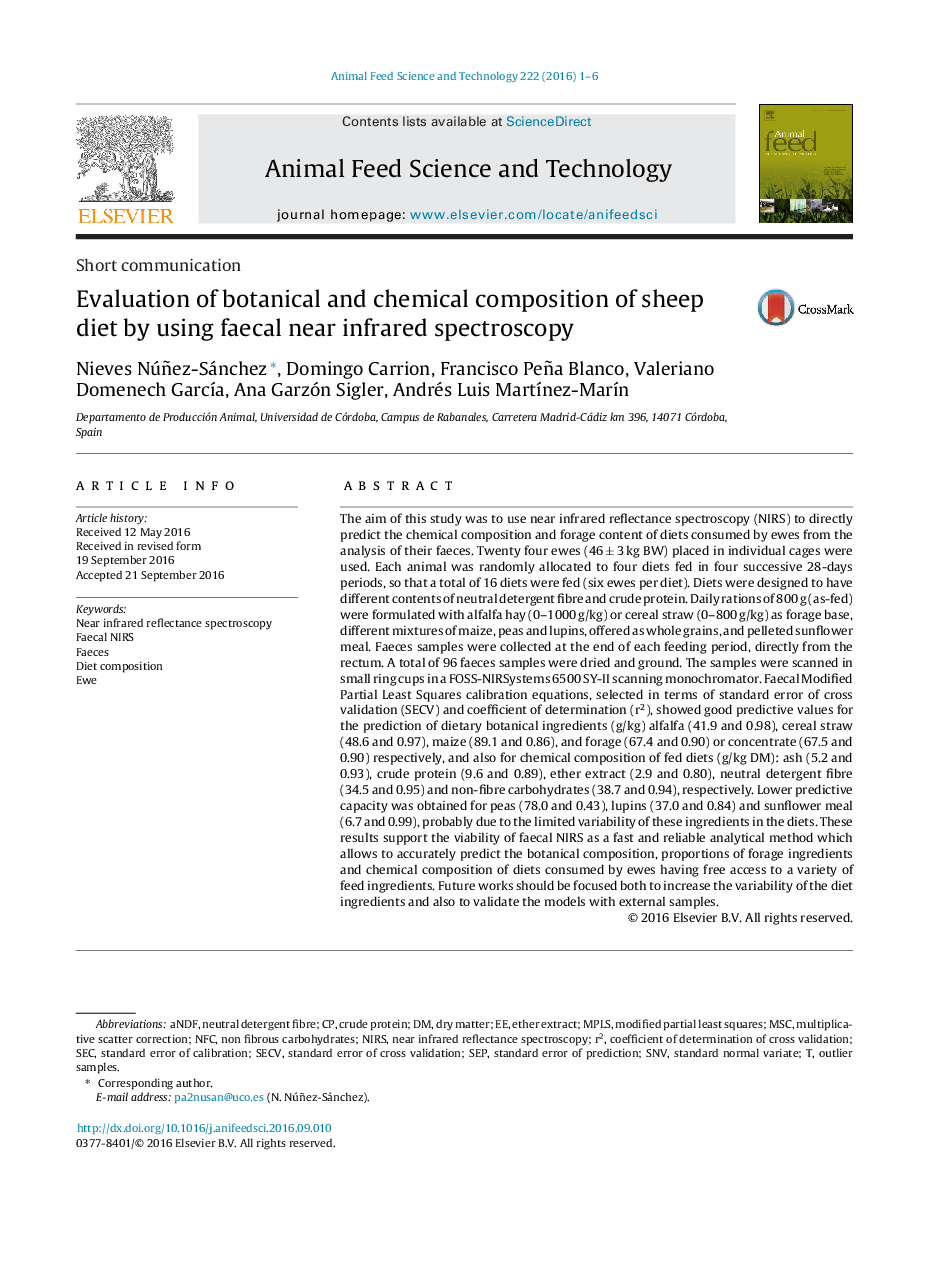| کد مقاله | کد نشریه | سال انتشار | مقاله انگلیسی | نسخه تمام متن |
|---|---|---|---|---|
| 5538817 | 1552364 | 2016 | 6 صفحه PDF | دانلود رایگان |
عنوان انگلیسی مقاله ISI
Evaluation of botanical and chemical composition of sheep diet by using faecal near infrared spectroscopy
ترجمه فارسی عنوان
بررسی ترکیبات گیاهی و شیمیایی رژیم های گوسفند با استفاده از طیف سنجی نزدیک به مادون قرمز
دانلود مقاله + سفارش ترجمه
دانلود مقاله ISI انگلیسی
رایگان برای ایرانیان
کلمات کلیدی
aNDFSECMPLSMSCNFCNIRSSEPSNVEWESECVStandard normal variate - استاندارد عادیDiet composition - ترکیب رژیم غذاییmultiplicative scatter correction - تصحیح پراکندگی multiplicativeModified partial least squares - حداقل مربعات جزئی جزئی اصلاح شدهstandard error of cross validation - خطای استاندارد اعتبارسنجی متقابلStandard error of prediction - خطای استاندارد پیش بینیStandard error of calibration - خطای استاندارد کالیبراسیونNear infrared reflectance spectroscopy - طیف سنجی بازتابی مادون قرمزether extract - عصاره اترFaeces - فاکتورneutral detergent fibre - فیبر مواد شوینده خنثیdry matter - ماده خشکcrude protein - پروتئین خام
موضوعات مرتبط
علوم زیستی و بیوفناوری
علوم کشاورزی و بیولوژیک
علوم دامی و جانورشناسی
چکیده انگلیسی
The aim of this study was to use near infrared reflectance spectroscopy (NIRS) to directly predict the chemical composition and forage content of diets consumed by ewes from the analysis of their faeces. Twenty four ewes (46 ± 3 kg BW) placed in individual cages were used. Each animal was randomly allocated to four diets fed in four successive 28-days periods, so that a total of 16 diets were fed (six ewes per diet). Diets were designed to have different contents of neutral detergent fibre and crude protein. Daily rations of 800 g (as-fed) were formulated with alfalfa hay (0-1000 g/kg) or cereal straw (0-800 g/kg) as forage base, different mixtures of maize, peas and lupins, offered as whole grains, and pelleted sunflower meal. Faeces samples were collected at the end of each feeding period, directly from the rectum. A total of 96 faeces samples were dried and ground. The samples were scanned in small ring cups in a FOSS-NIRSystems 6500 SY-II scanning monochromator. Faecal Modified Partial Least Squares calibration equations, selected in terms of standard error of cross validation (SECV) and coefficient of determination (r2), showed good predictive values for the prediction of dietary botanical ingredients (g/kg) alfalfa (41.9 and 0.98), cereal straw (48.6 and 0.97), maize (89.1 and 0.86), and forage (67.4 and 0.90) or concentrate (67.5 and 0.90) respectively, and also for chemical composition of fed diets (g/kg DM): ash (5.2 and 0.93), crude protein (9.6 and 0.89), ether extract (2.9 and 0.80), neutral detergent fibre (34.5 and 0.95) and non-fibre carbohydrates (38.7 and 0.94), respectively. Lower predictive capacity was obtained for peas (78.0 and 0.43), lupins (37.0 and 0.84) and sunflower meal (6.7 and 0.99), probably due to the limited variability of these ingredients in the diets. These results support the viability of faecal NIRS as a fast and reliable analytical method which allows to accurately predict the botanical composition, proportions of forage ingredients and chemical composition of diets consumed by ewes having free access to a variety of feed ingredients. Future works should be focused both to increase the variability of the diet ingredients and also to validate the models with external samples.
ناشر
Database: Elsevier - ScienceDirect (ساینس دایرکت)
Journal: Animal Feed Science and Technology - Volume 222, December 2016, Pages 1-6
Journal: Animal Feed Science and Technology - Volume 222, December 2016, Pages 1-6
نویسندگان
Nieves Núñez-Sánchez, Domingo Carrion, Francisco Peña Blanco, Valeriano Domenech GarcÃa, Ana Garzón Sigler, Andrés Luis MartÃnez-MarÃn,
